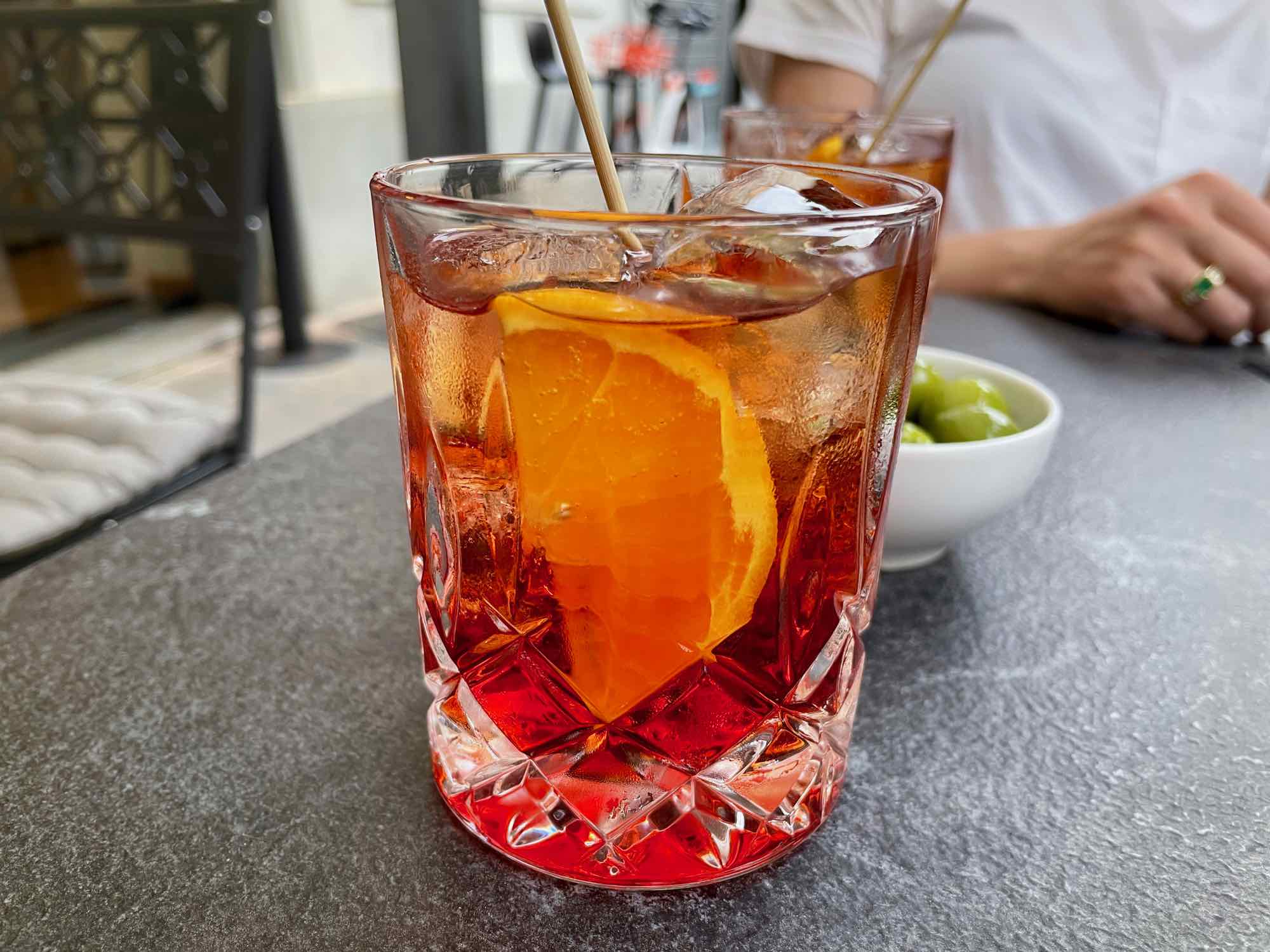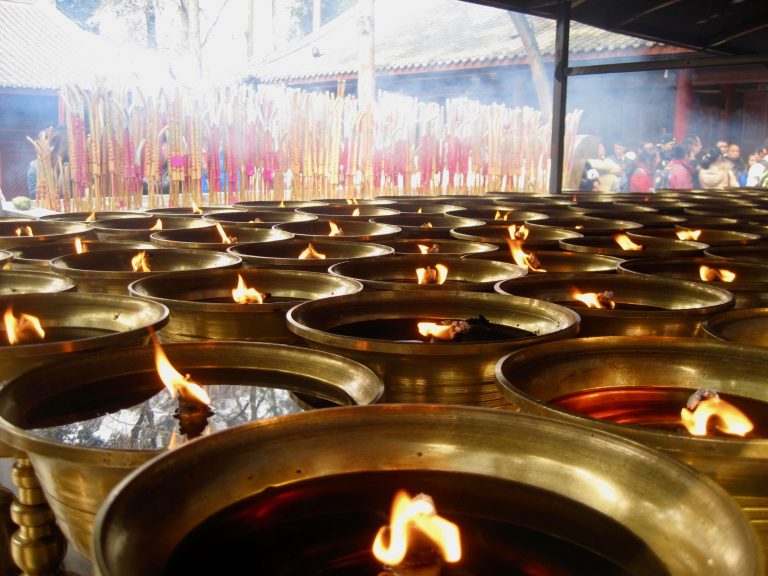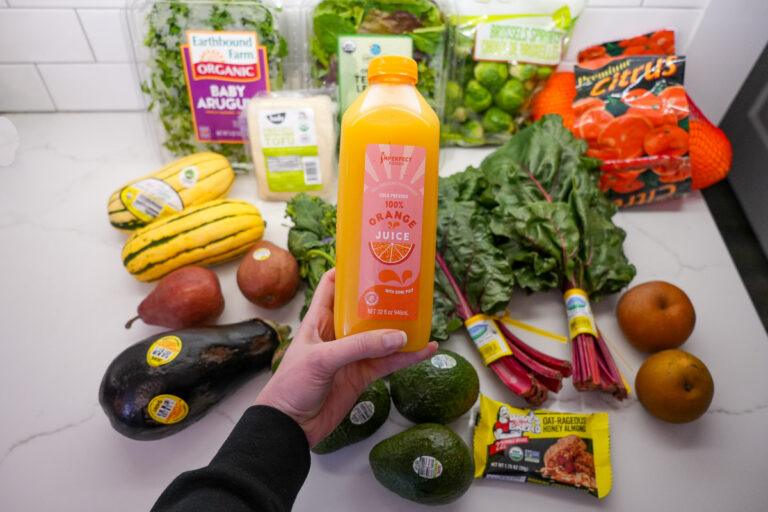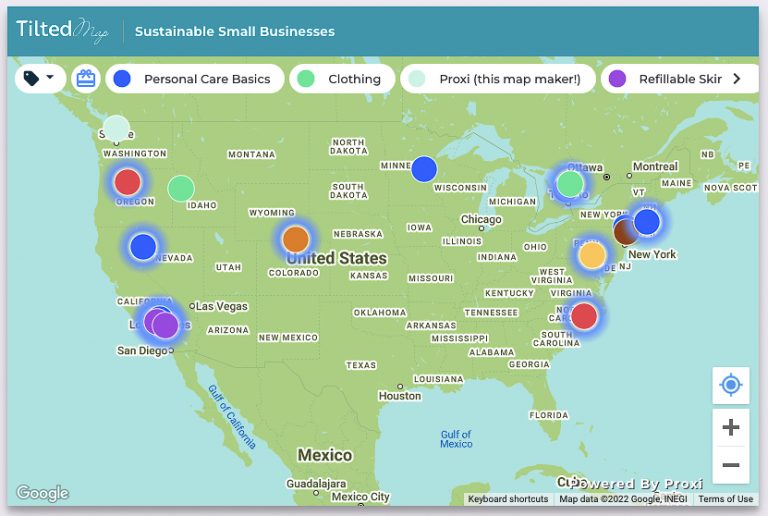Aperitivo: What to Expect in Italy (+ Expert Cocktail Recipes for When You Get Home)
All about the meaning of aperitivo in Italy, the history of the cocktails, and three expert recipes for the classic Italian aperitivo cocktails: the (Aperol) Spritz, Negroni, and Sbagliato. Enjoy!
A recent highlight of life in lockdown came when I tuned in to a virtual aperitivo cocktail party – the kind we’ve probably all had with someone in recent months, even if only a Zoom work meeting with a hidden glass of wine.
But this aperitivo was something unique. It was hosted by James Beard Greens, a fun and progressive organization for young foodies. And the special guest was Joe Campanale, a New York City restauranteur, cookbook writer, and bona fide Italian wine and cocktails expert.
I watched from my couch in Chicago as Joe chatted from his kitchen in NYC about the history of aperitivo, and demonstrated his own expert recipes for the classic aperitivo cocktails.
“Aperitivo in Italy isn’t just an aperitif,” (meaning any before-dinner cocktail, like a martini). “Aperitivo is a feeling. It’s a time of day.”
Joe Campanale
When I heard that I thought, this guy knows what he’s talking about.
Outside of Italy, people usually talk about these Italian cocktails as just that – cocktails. But they’re really part of a culture of aperitivo that goes far beyond the drinks.
Recipes:
You can jump straight to the recipes, or stay tuned for more about Italian aperitivo culture below.
Note: These aperitivo cocktail recipes (which I’m sharing with Joe’s permission) are true classics – not the new, fancy kind of cocktails you see on big city cocktail menus in the US.
I’ve included his useful suggestions for substituting artisan ingredients that are a little more local (depending on which side of the Atlantic you’re on) than the original, now mass-produced, Italian Aperol and Campari. But these cocktails are not remixes! They’re the classic drinks that people actually order at aperitivo in Italy.
So what is aperitivo?
The aperitivo tradition started in Venice in the early 1900s, then spread to Milano and Torino. Beyond being a “feeling” and “a time of day” (both true), aperitivo is when Italians transition from the work day to the rest of life. It’s a moment to take a deep breath, relax and let the day go. A casual, easy-going phase of the day that combines a little bit of food (sometimes a lot) and a little bit of drink. Aperitivo is also an excuse to get together with friends without the time commitment of dinner, or the expense.
You can’t quite translate it as “appetizer,” which is just one course of an Italian dinner. Aperitivo is usually totally separate.
All around Italy, you’ll see restaurants’ sandwich boards advertising aperitivo as “happy hour” to tourists, but that’s not right either. In the US at least, happy hour means discounts. It’s an hour of the day (or three hours) where appetizers are buy-one-get-one-free, or a few drinks have special prices.
But aperitivo is not a sales ploy, it’s a tradition. It’s part of the very social culture of everyday life in Italy.
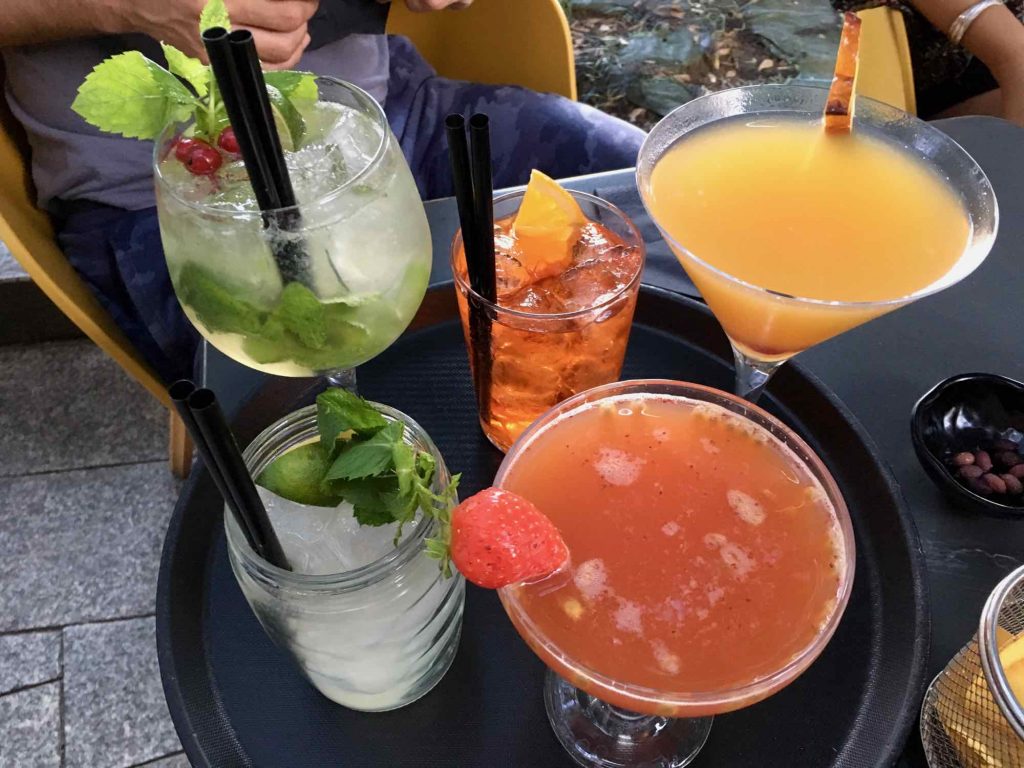
Aperitivo Food – Two Styles
Italians often stop for aperitivo before going home after work. Milan, my former home and probably the capital of aperitivo in Italy, is full of bars and restaurants offering buffets of pasta salads, focaccia, cured meats (affettati), cheeses, chips, olives and sometimes desserts, usually for €10 to €15 (which includes a drink). And since the city is full of young, broke office workers, this kind of aperitivo in Milan often replaces dinner.
But in most places, including some bars in Milan, the food part of aperitivo is a lot more restrained. Instead of a buffet, the server brings some combination of olives, potato chips, cheeses, prosciutto or other types of cured meat or house specialties. (But not enough to replace dinner, just enough to get you through to Italian dinner time – 8 pm at the earliest.)
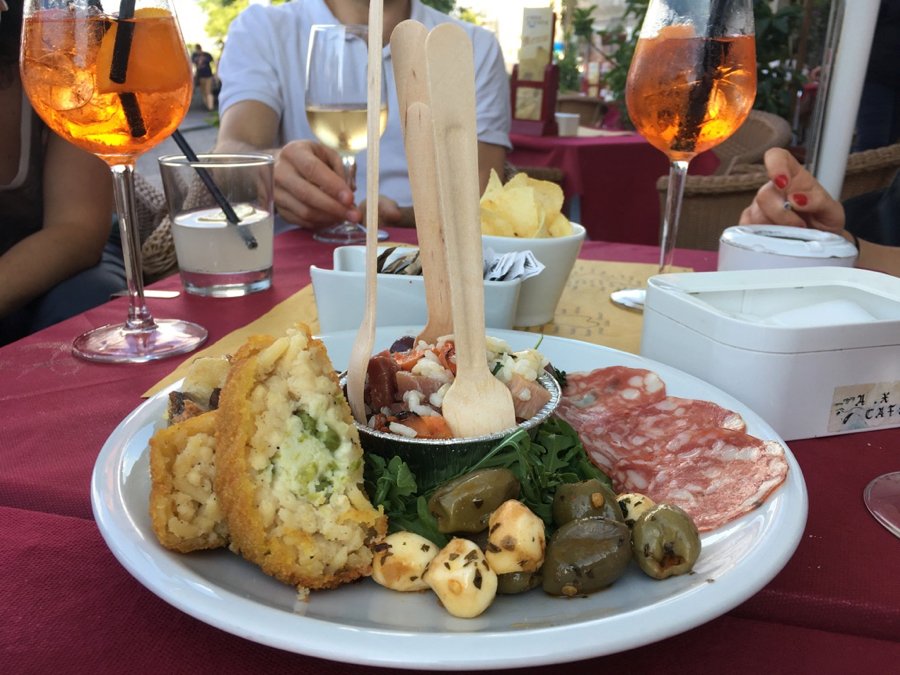
Italian “Drinking Culture”
Joe pointed out that most of these cocktails are pretty low alcohol content, and Italians really don’t go out for aperitivo trying to get drunk.
I definitely agree with him on that. When I first moved to Milan, it was hard for me to believe that Italy didn’t really have a “drinking culture.” In fact, I used to laugh at the term, thinking heavy drinking was universal, so why even mention it as being part of a culture?
Why did I think this? Well first of all, I grew up in rural America, land of whiskey drinkers, keg stands, and beer pong. Then I’d lived in Spain as an exchange student (which might have skewed my perspective on “normal” Spanish drinking, but still), and in China, where beer and gut-destroying baijiu flow freely, especially for men. Plus, in lots of countries where I’d traveled, from Eastern Europe to Latin America, heavy drinking was just a given.
But it’s true. I think the way Italians drink is much more restrained than what I’ve seen, perhaps anywhere else. Moderation is usually the name of the drinking game in Italy: A cocktail or light beer for aperitivo, a glass or two of wine with dinner, and maybe an amaro after dinner (or some other kind of “digestive” liqueur, like limoncello). But people don’t pound beers, and shots are a foreign concept – and I’m pretty sure this is part of how Italians mostly stay thin.
Italy’s Aperitivo Drink Menu
Don’t worry, if you don’t want to drink, you’re still invited for the fun and snacks of aperitivo! Several non-alcoholic drinks are classics for aperitivo in Italy. Crodino is my favorite, although I definitely didn’t like it at first. It’s a rather bitter tasting soft drink with a flavor that’s hard to describe. I’ve never had anything quite like it anywhere else. Another option is Sanbittèr Rosso. Either one will be much more interesting than a plain old coke!
(In the meantime, you can order either on Amazon to try. Sanbittèr is here, and Crodino is here.)
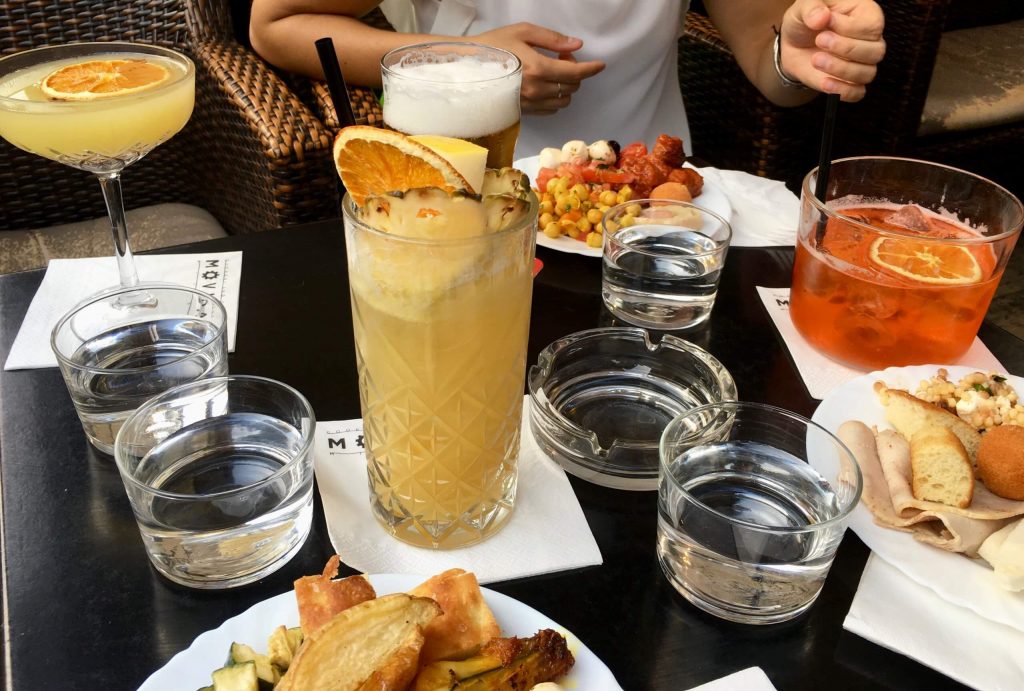
Beer and wine are perfectly acceptable choices at aperitivo – usually a small draft beer, or a glass of still white wine or Prosecco. But the four cocktails below are really the essence of aperitivo in Italy:
The Americano Cocktail
The Americano isn’t actually something you’ll hear ordered very often in Italy today – at least not as much as the others on this list. But 100 years ago you probably would have, and it’s the foundation for the cocktails that are more popular in Italy today. (It’s also pretty much the lightest of the classic aperitivo cocktails, in terms of alcohol.)
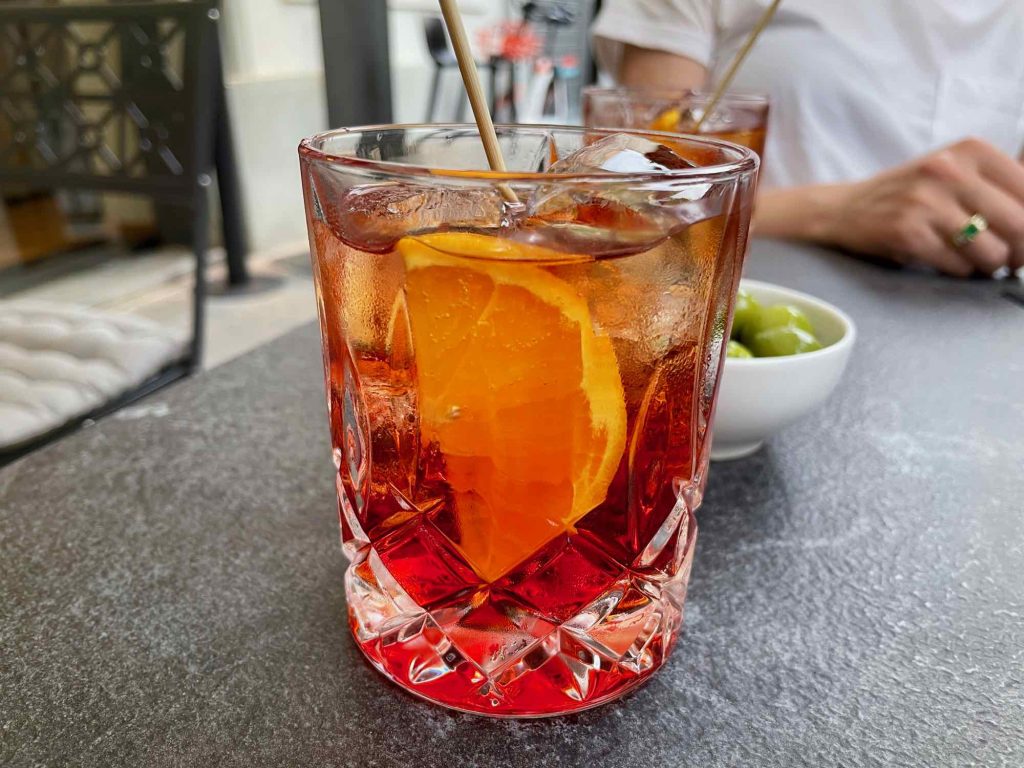
Joe didn’t give an exact recipe for an Americano, but it’s made with Campari, red vermouth, and soda water. Those first two ingredients are also the basis for the next two recipes – the Negroni and Sbagliato:
Campari is a type of bitters that shows up in a lot of Italian cocktails. It’s a bright, dark red color, about 20% alcohol, and is really strongly bitter tasting. The Campari brand is from the small town of Novara, near Milan but in the Piemonte region (northwestern Italy). It’s been around since 1860.
Surprisingly, I haven’t seen Campari on Amazon or Eataly online. Local liquor stores might carry it, or you can order it from Drizly (delivered to your door within an hour). Or you can try the artisan alternatives that Joe suggests in his recipes below.
Vermouth is a fortified wine flavored with anything plant-related (herbs, spices, flowers…). The modern style of it was invented in Torino, the capital of Piemonte.
Even before the Americano there was the “Milano-Torino”: Just equal parts Campari and vermouth, named for the cities where the two ingredients come from.
Negroni
This is the exception that proves the rule about aperitivo not being for strong drinks. It’s probably the only powerhouse, boozy Italian cocktail that’s famous outside of Italy. For that reason, a Negroni can be more of a going-out drink, and is not the most common choice at aperitivo – but it’s definitely a choice!
As Joe told the story, the drink was named after an aristocrat named Count Negroni who had spent time abroad, living in London and trying to be a cowboy in the American west. When he came back to Italy, he picked up the habit of ordering his Americanos with gin instead of soda water, and thus the Negroni was born.
Dubious Stories of the Americano and Negroni
Now, I love a good origin story as much as everyone else, but I’m pretty skeptical about some of these. Everything I could find says that the Negroni was invented in Florence, most likely in 1919, and they agree with Joe’s Count Negroni story. Every article says that the Count liked to “order his Americanos” with gin instead of soda water. Okay, fine.
But then I also found so many articles saying the Americano was named after an Italian boxer, Primo Carnera. When he won the World Heavyweight Championship in New York City, everyone started calling him “l’Americano,” and the drink was invented in his honor. But that fight was in 1933. So how was Count Negroni already ordering “an Americano with gin” if the Americano hadn’t been invented yet?
One article I found claims the Americano was so-named because it was the favorite drink of American expats living in Italy during prohibition. Others say it was invented even earlier, in a bar in Milan, owned by Mr. Campari himself, in 1860. (That’s the one that seems most likely to me.)
Joe Campanale’s Classic Negroni Recipe:
- 1¼ oz gin (37 mL); favorites include The Botanist, Reisetbauer Blue Gin or St. George
- 1¼ oz Campari (37 mL); or substitute with Contratto Bitter or Cappelletti
- 1¼ oz sweet vermouth (37 mL); favorites include Cocchi Vermouth di Torino, Antica Torino, Bordiga Rosso
- Orange twist for garnish. Grapefruit rind also works well!
Directions:
- Stir all liquid ingredients together with ice
- Strain into a chilled rocks glass filled with ice
- Garnish with an orange twist
(Negroni) Sbagliato
The full name of this drink is Negroni Sbagliato, but in Italy everyone just calls it a Sbagliato, which means wrong, mistaken, incorrect. Basically, a messed-up attempt at a Negroni.
(Pronunciation: The frustrating gl in Italian is pronounced like -lya, and the sb is really close to an sp sound. So it’s something like “spah-lyee-AH-toe.” I know, it’s not easy.)
Joe said the origin story behind this recipe was that a busy bartender making a Negroni accidentally threw in some Prosecco instead of gin. The customer had been waiting so long they allegedly just said, “It’s fine! I’ll take it anyway.”
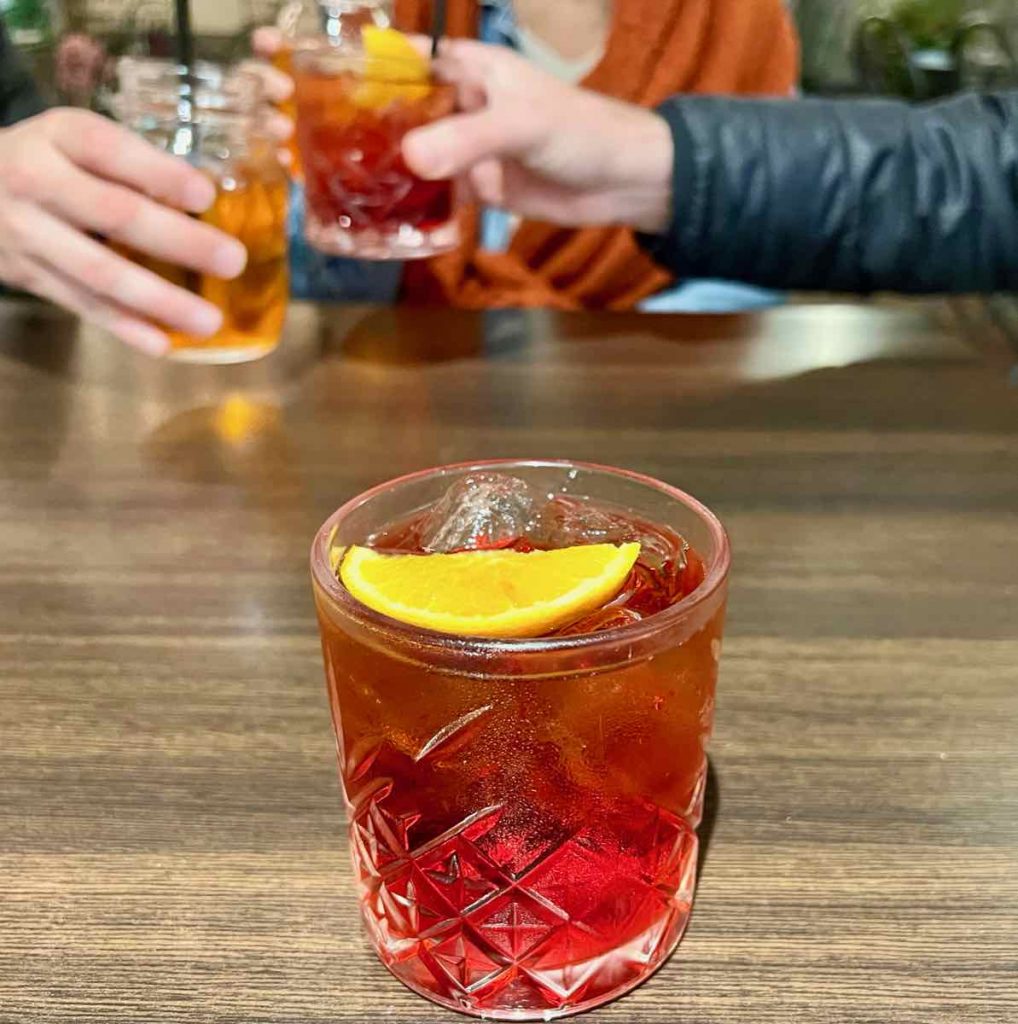
I like the story, and I’ve heard it repeated more times than I can count, but honestly, I find that reaction pretty impossible to believe, based on how precise Italians are about any kind of food or drink (and how grumpy Milanese are).
I appreciate that pickiness about food – when it’s not driving me crazy – because it keeps Italian food culture alive. But I would bet a plate of Risotto alla Milanese that the reaction involved much more swearing and was more like, “Questo cocktail è sbagliato!!” (“This cocktail is wrong!!”) Not, “No worries, thanks!”
Either way, you can visit the bar where this happened. It’s called Bar Basso, and it still stands on the northeast side of Milan.
Joe Campanale’s Negroni Sbagliato Recipe:
- 1 ½ oz Campari (45 mL)
- 1 ½ oz red vermouth (45 mL); favorites include Carpano Antica Formula, Contratto Rosso or Cocchi Rosso
- 2 oz dry sparkling white wine (60 mL), such as Prosecco or Cava
- Orange wedge for garnish; a grapefruit wedge also works well!
Directions:
- In a large wine glass add the ice and then the sparkling wine
- Add the Campari and red vermouth
- Give one stir so as not to stir out all the bubbles!
- Garnish with the orange wedge
(Aperol) Spritz
The Spritz is the most easy-going aperitivo cocktail, probably the most popular one in Italy, and my personal favorite (apart from a simple glass of prosecco). It’s also feels the least like a real cocktail – more like wine-y juice.
A lot of that easy-goingness comes from the fact that it’s usually made with Aperol instead of Campari. (But it’s not uncommon in Italy to order a Spritz with Campari instead of Aperol, if you like that extra bitter kick.)
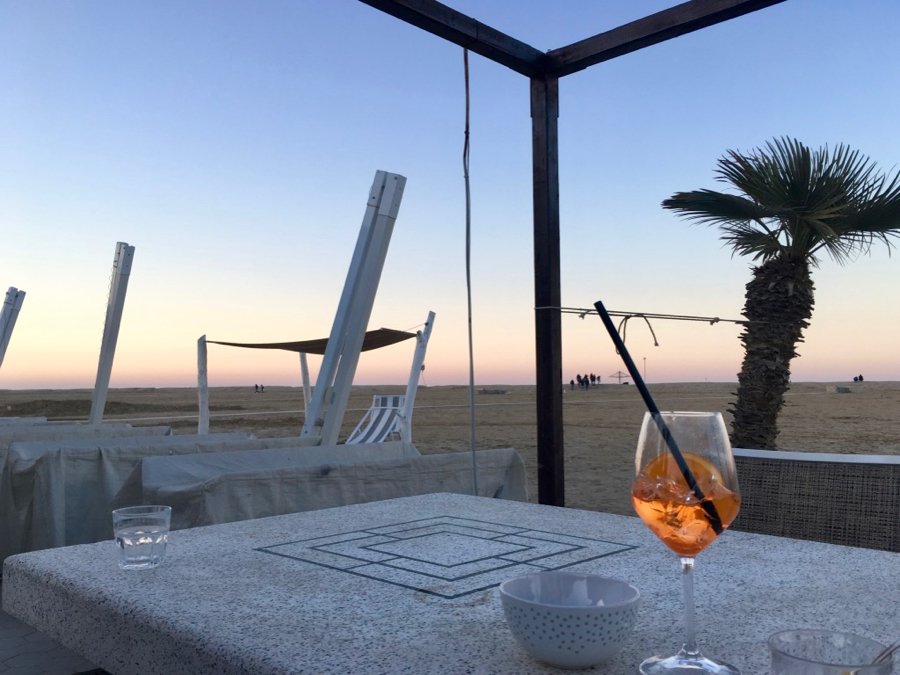
Aperol is another brand of bitters – like Campari, but much more chilled-out. It’s the easy-drinking one, with a grapefruit-y flavor, a bright, playful synthetic orange color and only about 11% alcohol.
Aperol is from the town of Padua, in the Veneto region (of northeastern Italy) and has been around since 1919. (You can order Aperol on Amazon here, look for it at a local liquor store, or have it delivered from your local liquor store by Drizly.)
The Aperol Spritz was invented in Venice, by adding the local bitter (Aperol) to a traditional Austrian white wine spritzer. The Venetians originally garnished the drink with a green olive instead of an orange slice, although I rarely see that now in Italy.
Joe described Aperol and Campari as “like junk food for adults,” which is spot on – and Italy doesn’t really have a lot of junk food, so they deserve these.
But what Joe was saying is that while Aperol and Campari are classic Italian brands, they’re also full of sugar, preservatives and artificial colors. That’s why his recipe uses Contratto Aperitif, a more artisan alternative to Aperol.
Joe Campanale’s Doppio Spritz Recipe:
*Note: A more traditional Spritz recipe uses Prosecco, soda water, and just one type of bitters – either Aperol or Campari, or an artisanal substitute, like the ones Joe recommends below. But here, he’s using two bitters – hence the name – Doppio, or Double Spritz.
- 1 oz Contratto Aperitif (30 mL)
- 1 oz Forthave Aperitivo (30 mL); or Contratto Bitter, Cappelletti or Campari as a substitute
- 1 oz tonic water (30 mL)
- Soda water, to top
- Orange wedge and/or green olive for garnish
Directions:
- Combine all the ingredients in a rocks glass over ice
- Stir to integrate
- Garnish with an orange wedge and a green olive
Spritz Tips!
Joe recommended putting the soda on the bottom, then adding the bitters, and the Prosecco last. This way you don’t have to stir – which can make the you lose the Prosecco bubbles!
He also said grapefruit works well as a garnish instead of orange, but lemon or lime do not.

Another tip I loved: It’s okay if these drinks are not exact.
Joe taught me an Italian word I had never heard: Sprezzatura. A kind of carefree nonchalance. An effort to make everything – art, cocktails, or life in general – appear effortless yet elegant.
He said the Spritz is the perfect example of this attitude, because it doesn’t have to be exact to be good. Maybe that’s what I love about it.
And it’s definitely nice to have the confirmation from a pro, because my own at-home Spritz recipe is usually something like this:
- Throw a couple of ice cubes in a glass (if I remembered to refill the tray).
- Add a slug of adult junk food (Aperol).
- Fill the glass about half-way with Prosecco.
- Add a dash of sparkling water on top (if I have it, which I usually don’t, so instead – more Prosecco).
- Squeeze in some kind of citrus. I also like the classic green olive touch, so I’ll throw one in the glass, and a few in a dish for aperitivo.
It’s pretty delicious that way, too.
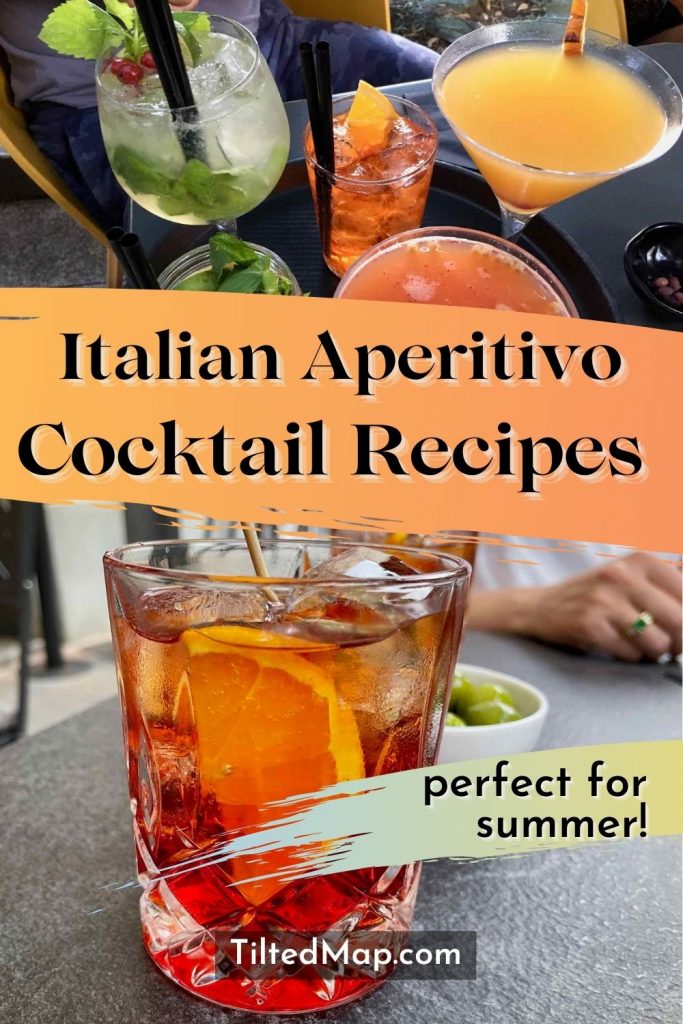
Thank You’s and a cookbook!
A big thanks to Joe Campanale, co-owner and beverage director of the restaurant Fausto in Brooklyn, NY, for sharing his time and his cocktail recipes!
He’s also the co-author of a cookbook called Downtown Italian: Recipes Inspired by Italy, Created in New York’s West Village, which you can order at the link above on Amazon, or from the indie seller Bookshop. (And he’s working on another book about natural Italian wines, which I’m definitely looking forward to.)
Thanks also to James Beard Foundation Greens for organizing this online event – one of many that’s helping keep me sane and connected in quarantine times. I think JBF Greens is a really fun organization, with a progressive take on food and food reviewing. They’ve been hosting lots of events like this one during the pandemic; you can find more information at the link above. (While you have to be based in Chicago or NYC to become a member, the online events are mostly free and open to the public.)
More About Italian Food (If You Liked That Post, Read These):
I linked to both of these posts above in the text, but I’ll put them here too, because they are very much related:
- How to Eat in Italy: the Ultimate Travel Guide to Italian Meals & Courses
- How Italians Stay Thin Eating Pizza & Pasta All the Time (Or, how Italians actually eat, and why I think it’s so brilliant.)
- After three years as an expat in Milan, my favorite restaurants in Italy

